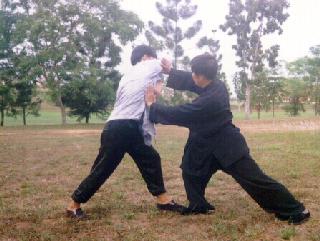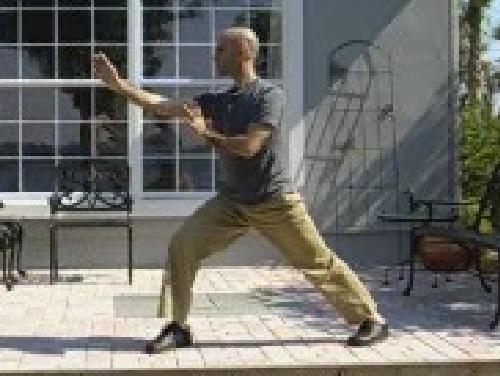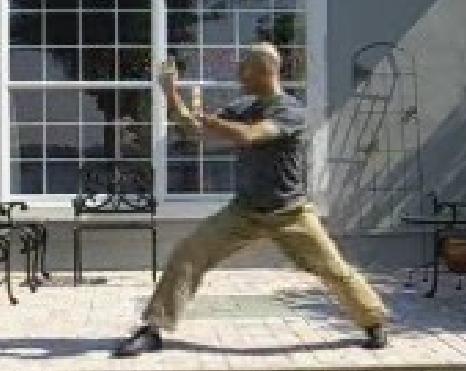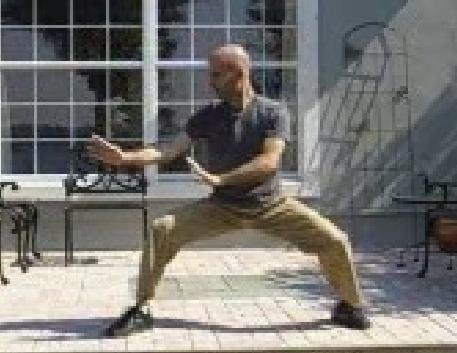CAN ONE YIELD AND COUNTER IN THREE SECONDS OR LESS?
The following discussion is reproduced from the thread A Discussion on Yielding started in the Shaolin Wahnam Discussion Forum on 14th February 2006. The name of a main contributor to this thread is removed as requested by him, and is replaced by “Challenger” or any term appropriate to the occasion. As the discussion is long, it is presented here in parts.

Sifu Wong demonstrating the yielding, defelecting and countering an opponent in less than one second
 Sifu Marcus Santer
Sifu Marcus Santer
Instructor, Shaolin Wahnam England
17th March 2006
Quote (Originally posted by Challenger)
“I would never pull or push anyone as depicted in your photo, so your example and comments thereof are totally irrelevant!.”
Challenger, I am disappointed by your reply, I've come to expect more from you. I will not labour the point of how to push or how to pull someone. I think Anthony (Post 157) has covered this point adequately and I wish to keep the thread “on topic”.
I'd like to thank Momo, Anthony, Alex and Andrew for confirming the effectiveness of the material I have posted.
Pre-empting the reply of “Yes, but they are Shaolin Wahnam students etc, etc, etc”. I earnestly invite everyone to try out both versions of Push and Pull and to decide from their own direct experience which they prefer. Challenger, would you be generous enough to provide pictures of your techniques so that readers are able to make a fair comparison?
I'm currently busy compiling the information and pictures that will enable us to explore Yielding as it is applied to Kicks. This should be ready towards the end of next week. Thank you for your patience, it will be worth the wait.
Kind regards
Marcus
 Counter against the Pull
Counter against the Pull
Chris3212
17th March 2006
Dear all,
I practiced the sequences with a friend and although im am not an experienced practitioner I can definitely see the effectiveness even for a beginner.
Best wishes,
Chris
__________________
"To know the riches of the martial arts, begin by standing still" - Grand Master Wang Xiang Zhai
 Sifu Andrew Barnett
Sifu Andrew Barnett
Instructor, Shaolin Wahnam Switzerland
17th March 2006
Thank you for your independent evaluation Chris. If you wouldn't mind me asking, how long did you need to perform the entire flow of patterns for each of the sequences shown?
Thanks,
Andrew
__________________
Andrew Barnett
Shaolin Wahnam Switzerland
http://www.shaolin-wahnam.ch
Chris3212
17th March 2006
Dear Sifu Andrew,
The first sequence took a mere 5 minutes. And I, and my friend were easily "yielding" if that's the right word for that movement and throwing within 3 seconds. It is very much like a sequence in our style, although ours isn't internal.
The second sequence took a little longer, but we both agreed that after about 15 minutes constant practice it was done rather well.
Please note that I may not have been "rooted" as well as a Wahnam practitioner might be or executed the sequence with as much skill.
Best wishes,
Chris
Simon Brooks
Assistant Instructor, Shaolin Wahnam England
17th March 2006
Seeing as I can't really remember what the initial argument was and that there may be some differences in the philosophies of Kung Fu and Tai Chi I want to try and understand the place of yielding alongside other tactics.
In Kung Fu we often talk about two stages of development in reacting to an attack.
- Defence followed by counter.
- No defence, direct counter.
In the first we learn to defend against the attack with a suitable “lean” or “loat”. This is normally done while stepping or shifting weight backwards.
In the second our defence is actually a direct attack. We either strike the attacking limb or intercept the movement normally closer to the root of the movement.
Let's briefly define a yield as withdrawing just beyond your attacker's reach and then following them back in to deliver a counter. I suppose that if the yield is done well enough your opponent may just topple forward into a heap but we'll put that aside for the minute.
Does that mean that yielding is inferior to the direct counter? Why do some of the Shaolin animal styles and Tai Chi prefer yielding when others do not? Does Tai Chi have direct counters?
Lot's to think about.
Simon
Joko
Quote
“Why do some of the Shaolin animal styles and Tai Chi prefer yielding when others do not? Does Tai Chi have direct counters?”
Oh, yes, definitely.
An example of a direct counter would be 'Side Kick' against Thrust Punch, another one would be "Jade Girl Threads Shuttles".
kai xin... hao yunqi...
_____________________________________________
Be happy n joyful... and share the joy with others
 Counter against the Push
Counter against the Push
Clive
17th March 2006
Yielding
It seems to me, that different people are using the word yielding in different ways. To illustrate my own understanding of yielding, I will pass on a story told by my Tai Chi teacher concerning Dr Chi Chiang-tao:
Quote
.
“There was one famous Chi Kung master, revered because of his enormous size and strength. He could be found regularly in the park each morning with his disciples going through the most rigorous 4hr Chi Kung exercises. As was the custom, anyone could challenge anyone. So once a year Dr Chi took to going up to this man mountain and asking if he would Push Hands with him. Each year he would agree and push Dr Chi with enormous power back 15 feet or more. Each time Dr Chi would bow and thank him and go away to practice yielding some more.
Each year he would come back and request again and each year the same thing would happen, except that each time he would be thrown less far. This went on for 15 years! Until one year the man mountain gave Dr Chi his annual push but this time his yield was equal to the power of the push and Dr Chi remained standing in the same place. Dr Chi bowed once more and continued with another year of practice and returned a year later. "This time" said Dr Chi, "When the Sifu push me, I yield and just gently pull sleeve. Sifu, he need take step! I very happy! You see, yield overcome force!”
Dr Chi's principal teacher was Cheng Man Ching, but prior to moving to Taiwan, he had studied under the guidance of Master Chang Teh-Fu whose teacher was Li Ching-Lin, whose teacher was Yang Pan-Hou
As you can see from the story, yielding is more than simply moving beyond reach and then sticking/following them as they retreat.
Remember those times when you attempt to apply a technique and although your partner/opponent is right there, in range, there just seems nothing to push/pull/kick etc. against? That for me is what I mean by yielding .
 Sifu Anthony Korahais
Sifu Anthony Korahais
Instructor, Shaolin Wahnam USA
17th March 2006
Yielding and Skill
Hi Clive.
Nice story. I like stories. (Smile)
However, I might point out one thing. What is being described in that story is not yielding per se, but skill. I agree that there are different interpretations of the word yielding. You have one, I have one, Sifu Stier has one. But regardless which interpretation you have, each of them requires skill.
If you try Marcus' counters against Sifu Wong, they won't work. Not unless you have more skill and force than him. (It's important to remember that in Chinese, the word for skill (gong) includes a concept of force.)
Also, the story above is talking about pushing hands, which is a drill. There are rules to pushing hands (tui shou). Most of the pushing hands that I've seen and/or learned insisted on maintaining arm contact. Yielding without contact is not even an option. This might account for why some Taijiquan practitioners don't recognize the no-contact versions as yielding.
Even a no-contact yield requires skill, particularly in terms of spacing and timing. But the follow-up also requires force. The videos I posted earlier of myself showed a Shaolinquan version of yielding. If you watch, you can see me slightly uproot my partner after the yielding phase when I return with a strike. I effectively go through his strike once it has been spent. This requires both force and skill.
I fully agree that yielding can be more than simply moving beyond the reach of a strike. There are subtleties of timing, spacing, and force that are difficult to describe with words. Nevertheless, much depends on the skill level. For a master, yielding can be profound. But for a beginner, simply moving beyond the reach of a strike using the proper timing and spacing is a form of yielding.
According to me, at least. (Smile)
__________________
Anthony Korahais
Clive
17th March 2006
Skill
Dear Antonius,
I'm not sure what you meant by:
Quote
"What is being described in that story is not yielding per se, but skill."
But I agree with you that skill is required and that there are levels of ability.
One of the things that I take from that story is the persistence required to develop the profound yielding characteristic of a master.
I'm sure that my understanding is limited - that's why it's so interesting to be given a chance to share other people's. It reminds me of one of Ted Wragg's (educator and columnist) favourite sayings: if you come across someone doing something right, steal it!
Sifu Anthony Korahais
Instructor, Shaolin Wahnam USA
18th March 2006
Morning, Clive.
Let me try to clarify. What I meant was this: In the story, Dr. Chi was yielding for all 15 years. The reason it didn't work in the beginning was not because he wasn't yielding, but because the other master had superior gong (force & skill). If Dr. Chi had tried against someone with inferior gong, then he would have been able to apply they yield successfully.
I agree that it requires persistence to develop the skill of a master. But yielding is not only for masters. It can be practiced and used on many levels. The same applies to other tactics, like the "no defense, direct counter" that Simon was talking about earlier. Fresh beginners learn this tactic in our school with the pattern "False Leg Hand Sweep."
Beginners use the technique to sweep at the attacker's striking arm. If neither person has internal force, then the sweep will cause the attacker some pain. But someone like Sifu Wong can use the same technique with much more skill. If he sweeps the arm of someone with inferior force, their arm will break.
It's not that beginners aren't doing "no defense, direct counter," but rather that they are doing it with a lower level of skill and force.
Best,
__________________
Anthony Korahais



Sifu Anthony yielding and countering in one second
BeggarSu
19th March 2006
I just wanted to add that the counter to pulling that Sifu Marcus kindly provided from Shaolin Kung Fu is the common application of Cross Hands Thrust Kick usually shown in Yaolin Taijiquan.
 Sifu Marcus Santer
Sifu Marcus Santer
Instructor, Shaolin Wahnam England
2nd March 2006
Hello Clive,
Thank you for sharing your story, it raises many interesting points, most of which have been covered by Sifu Anthony (thank you). There are a few items I'd like to add:
-
My personal belief is that Dr Chi taking 15 years to learn yielding effectively is too long! I recall Sifu saying on several occasions that one of the main reasons he founded Shaolin Wahnam was to overcome such setbacks. There is a Kung Fu saying: “3 years small success, 10 years big success”. But considering our present standard, which is low compared to that of the past, this saying could be rephrased as “1 year small success, 3 years big success”. Though it is essential to have the 3 requirements for attainment (method, teacher and student for full details on this read p43-46 in Sifu's The Art Of Shaolin Kung Fu).
- Dr Chi's concept of Yielding seems similar to that of Sifu Stiers. He just yielded without continuing with the 2 other integral aspects: deflecting and countering.
Sifu has told me that even in the past Tai Chi Chuan practitioners would be happy if they could experience internal force after a year and be able to apply their patterns for combat after 3 years.
Today the situation is even worse, with some Masters claiming that there is no such thing as chi! (refer to question 3 ) and that they cannot apply their patterns in combat.
At the UK Summer Camp, Tai Chi Chuan instructors including masters can learn internal force and combat application within a few days! This is unprecedented and incredible. DO NOT take my word for it; this is a golden opportunity to find out for yourself if what I write is true. Full details of the England Summer Camp 2006 can be found here . I'm sure Sifu will also demonstrate Yielding in all its glory. (Smile)
Right, I'm off to enjoy the rest of the weekend.
Kind regards
Marcus
LINKS
